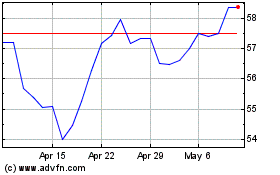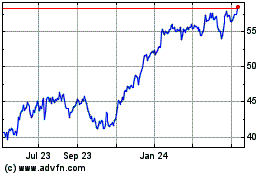By Ryan Tracy and Emily Glazer
WASHINGTON -- U.S. regulators slapped Wells Fargo & Co. with
new regulatory sanctions Tuesday, saying the firm failed to address
alleged "deficiencies" in a plan to manage its own bankruptcy
without a taxpayer bailout.
Four other huge banks avoided the sanctions: J.P. Morgan Chase
& Co., Bank of America Corp., Bank of New York Mellon Corp.,
and State Street Corp. The Federal Reserve and Federal Deposit
Insurance Corp. announced the verdicts Tuesday after saying in
April that the five banks didn't have adequate "living will"
plans.
Wells Fargo said in a statement that while it is disappointed by
the regulators' decision it will work closely with the agencies to
better understand their concerns. That said that it took early
regulator feedback "very seriously and took several steps to
address it," including creating a special office assigned to deal
with the living wills process.
The regulatory shortcoming, akin to failing a makeup test, is
yet another blow to Wells Fargo, which is still struggling with the
fallout from its sales-practices scandal. The firm, once a golden
child among big banks, paid a $185 million fine in September to a
separate set of federal regulators, along with a city official,
over opening as many as 2.1 million accounts with unauthorized or
fictitious customer information.
Since then, Wells Fargo has faced public and political
criticism. Former Chief Executive John Stumpf retired abruptly
after being grilled in two congressional hearings. The bank faces
many state and federal investigations, including from the Justice
Department and the Securities and Exchange Commission. Wells
Fargo's board is also conducting its own internal investigation.
The Office of the Comptroller of the Currency last month imposed
further restrictions on the bank's operations over that
controversy, and is looking at still further restrictions on the
bank's ability to expand.
As part of its efforts to mend relations with regulators, Chief
Executive Timothy Sloan, who took over in October, has been
traveling regularly to Washington, D.C. But Mr. Sloan has said in
meetings with bank executives and employees over the past several
weeks that matters will get worse before they get better, according
to people who attended the meetings and recordings reviewed by The
Wall Street Journal.
Mr. Sloan has also said the bank should expect tough times from
regulators across the firm, not just its retail banking unit. That
appears to be the case with the bank's submission detailing for
regulators how it would plan to go through bankruptcy -- also known
as a living will -- which is separate from issues related to the
sales-practices scandal. The new sanctions issued Tuesday opened a
whole new front of questions from regulators about the
institution's management, related to whether they are properly
structured, in the eyes of regulators, to respond to a new
financial crisis.
Earlier this year, Wells Fargo was the only bank that was
flunked for "material errors" in its living wills submission, with
regulators saying the bank had to make substantial revisions to its
plan. The announcement came as a surprise to it and the banking
industry, since Wells Fargo had, in an earlier round of tests, been
singled out as the only bank to lay out a viable bankruptcy
path.
Though big banks' size have often been their Achilles' heel in
the living wills, Wells Fargo's growth over the years wasn't its
problem. Instead, regulators said the errors called into question
"the extent to which there was appropriate internal review and
coordination." At that time, in April, regulators told Wells Fargo
that its errors included issues around the volume of its available
liquid assets, which "raises concerns regarding quality control,
senior management oversight, and recovery and resolution planning
staffing."
In assessing the new plan that Wells Fargo had submitted in
October, the Fed and FDIC said Wells Fargo still didn't adequately
address two of the three major concerns the agencies had raised.
Big banks must file the will under the 2010 Dodd-Frank law as a way
of ensuring that they can fail without needing a taxpayer
bailout.
The regulators for the first time invoked sanctions they are
empowered to use in Dodd-Frank when they determine a living will
isn't credible or wouldn't facilitate an orderly bankruptcy. Wells
Fargo will be barred from establishing international bank entities
or acquiring any nonbank subsidiary. The regulators could have but
didn't impose higher capital requirements on the firm, a
potentially stricter sanction.
Wells is expected to file a revised living will "addressing the
remaining deficiencies" by March 31, 2017, the Fed and FDIC said.
If the agencies still aren't satisfied, they will limit the size of
the firm's nonbank and broker-dealer assets to levels in place on
September 30, 2016, they said. After two years under the Dodd-Frank
sanctions, Wells could also potentially face requirements to divest
certain assets.
Tuesday's verdict came after months of regular meetings between
regulatory staff and the five firms to discuss aspects of the
living wills, from banks' derivatives businesses to their legal
structures.
In a letter Tuesday to Wells Fargo, the Fed and FDIC hit Wells
with withering criticism. They said when it came to the bank's plan
for potentially reorganizing legal entities it owns, "it is unclear
whether or under what circumstances WFC would take action or what
type of actions it would consider taking."
Mr. Sloan wrote to bank employees Tuesday afternoon that the
bank took "several steps" to improve its October resubmission after
getting regulator feedback, according to a memo reviewed by The
Wall Street Journal.
While he said that the bank will continue to work closely with
regulators "to better understand their concerns" he added that
"living wills are a form of contingency planning. They are not a
scorecard for the current health of Wells Fargo or any bank."
He added: "We believe our planning complements the practices we
already have in place for managing our capital, managing risk, and
planning for a variety of contingencies." He expects the bank to
address the agencies' comments in the time frame provided.
On the other hand, Tuesday's decision was a significant win for
J.P. Morgan, Bank of America and the other firms that regulators
rebuked in April.
Verdicts on the living wills are closely watched on Capitol
Hill, where advocates of breaking up megabanks have pushed
regulators to aggressively use this part of Dodd Frank to pressure
them to shrink or reduce risk.
Tuesday's decision didn't directly address whether the big banks
remain "too big to fail." In April, the five big banks, along with
Goldman Sachs Group Inc., Morgan Stanley, and Citigroup Inc., were
given a list of separate regulatory concerns that were required to
be addressed by July 2017, when all the firms must submit new
living wills. That will pose another test for each of the banks,
and it is possible that regulators could impose additional
sanctions on some firms if they don't make enough progress by
July.
By then, some of the regulators who voted on Tuesday's decision
may no longer be in office. President-elect Donald Trump's team has
indicated it wants to fill several empty slots on the Fed's
governing board, for example, including vice chair in charge of
bank oversight.
--Christina Rexrode contributed to this article.
Write to Ryan Tracy at ryan.tracy@wsj.com and Emily Glazer at
emily.glazer@wsj.com
(END) Dow Jones Newswires
December 13, 2016 17:50 ET (22:50 GMT)
Copyright (c) 2016 Dow Jones & Company, Inc.
Bank of New York Mellon (NYSE:BK)
Historical Stock Chart
From Mar 2024 to Apr 2024

Bank of New York Mellon (NYSE:BK)
Historical Stock Chart
From Apr 2023 to Apr 2024
